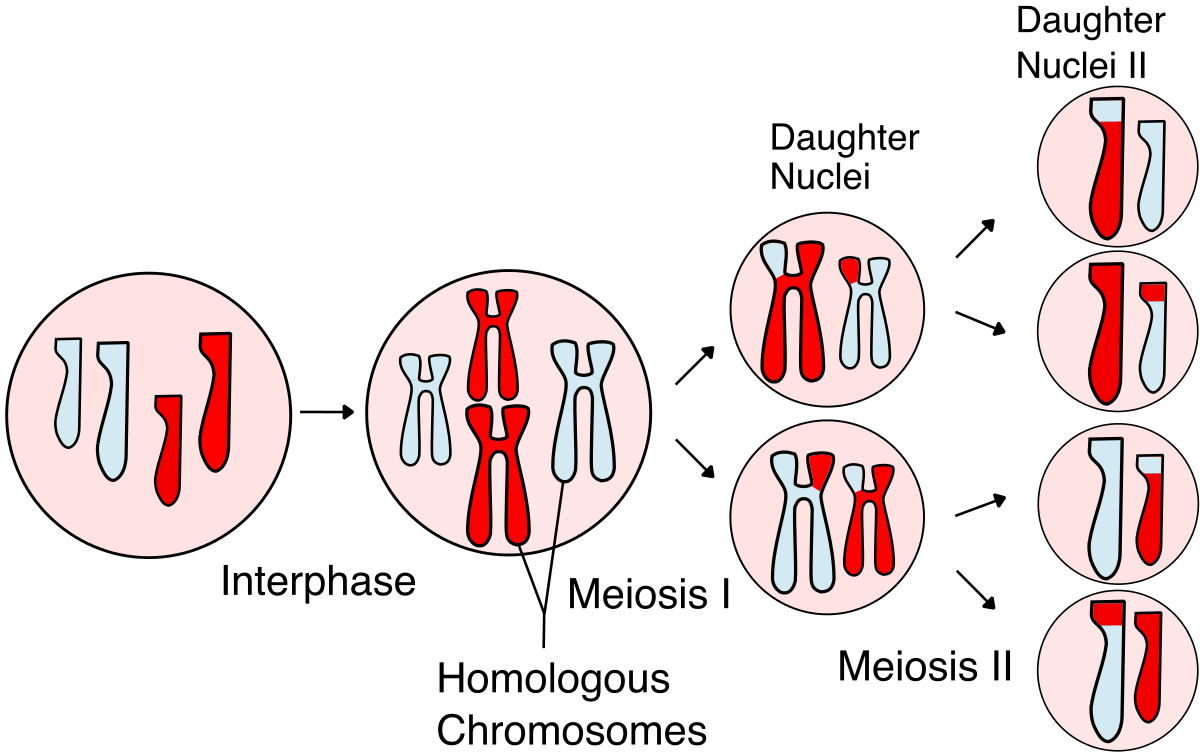Caroline Koffke
Haseung Jun
AP Biology 🧬
358 resourcesSee Units
Intro to Unit 5
5.1 Meiosis
Heredity is the concept of passing genes on from generation to generation. This starts with the creation of gametes, or sex cells, through cellular division called meiosis. Diploid organisms (us!) carry two copies of every gene, where one comes from the father and the other from the mother. Genetics is the study of this heredity.
Meiosis is the process that all organisms go through in order to produce gametes, or sex cells. The process differs from mitosis, the process of somatic cell division, in a number of key ways. Always remember that the purpose of meiosis is to create variation within the population. Meiosis involves one round of DNA replication and two rounds of cellular division. The resulting cells are all genetically unique from one another and from the parent cell. The resulting cells are also haploid, meaning that they have half of the genetic content of a typical somatic cell, or diploid cell

Image Courtesy of Wikipedia
The variation created by the process of meiosis leads to an infinite amount of variation in the living things on earth. This variation is the key to life and the continued success of all species.
5.2 Meiosis and Genetic Diversity
As mentioned before, the sole purpose of meiosis is to create variation. Three ways this is enhanced through meiosis is shown. The three are crossing over, independent assortment, and random fertilization. During crossing over, homologous chromosomes share genetic material by exchanging bits of the DNA.
Independent assortment refers to the way chromosomes line up. Instead of lining up in both dad aisle and mom aisle, the chromosomes can mix up, and line up essentially in any line. This creates more genetic diversity.
Lastly, random fertilization. This just refers to the random nature of fertilization. You can't choose which sperm and egg will join together. It means that two parents can't produce the same child twice.
5.3 Mendelian Genetics
Heredity was first described by Gregor Mendel who discovered simple rules of inheritance that we still use today. While many traits do not fit these rules, his work still provides a foundation that we can use to analyze the inheritance of genes between generations. Mendel looked at dominant and recessive alleles, in which one "wins out" the other. The dominant allele usually decides the phenotype.
Three important laws include the Law of Dominance, the Law of Segregation and the Law of Independent Assortment. Other non-Mendelian genetics have examples that include incomplete dominance, codominance and polygenic inheritance.
5.4 Non-Mendelian Genetics
Non-Mendelian genetics include genetics that don't invovle a dominant and recessive gene. Instead, there can be multiple alleles, incomplete dominance, co-dominance, and sex-linked traits. With mulitple alleles, it's not just two alleles that decide phenotype. There can be 3, 4 or more alleles that decide fur color for a rabbit.
In incomplete dominance, neither allele is dominant over the other. Instead, it's a mix of the two (red and white alleles make a pink color). Co-dominance is like incomplete dominance, except the two alleles are not mixed, instead, they are shown together. Think of a spotted cow, the cow has both white and brown skin.
Lastly, with sex-linked traits, the trait manifesting itself depends on your trait. Color blindness is an example. Men are more likely to be color blind because they only have one X chromosome.
5.5 Environmental Effects on Phenotype
The environment can also play a role in which traits become more frequent in a population. If one phenotype gives individuals a higher chance of survival and reproduction, this trait will be more common in the population than the others.
5.6 Chromosomal Inheritance
This is where we learn about Punnett squares! Fun! Punnett squares determine the probability for two parents to have an offspring with a specific phenotype or genotype. It's a way to look at probability. DNA is also coiled into chromosomal shapes in order to make distribution easier and fairer.
-1Nq7YrYJ2amN.png?alt=media&token=56f66971-0fd3-414d-a50f-90c6101d7352)
Image Courtesy of Wikimedia Commons
Key Terms
- Meiosis
- Diploid
- Haploid
- Gamete
- Chromosome
- Homologous chromosome
- Sister chromatid
- Genetic variation
- Crossing over
- Random fertilization
- Independent assortment
- Zygote
- Law of segregation
- Laws of probability
- Genotype
- Phenotype
- Allele
- Gene
- Sex-linked
- Pedigree
- Nondisjunction
- Mutation
- Mitochondria
- Chloroplast
Browse Study Guides By Unit
🧪Unit 1 – Chemistry of Life
🧬Unit 2 – Cell Structure & Function
🔋Unit 3 – Cellular Energetics
🦠Unit 4 – Cell Communication & Cell Cycle
👪Unit 5 – Heredity
👻Unit 6 – Gene Expression & Regulation
🦍Unit 7 – Natural Selection
🌲Unit 8 – Ecology
📚Study Tools
🧐Exam Skills

Fiveable
Resources
© 2025 Fiveable Inc. All rights reserved.